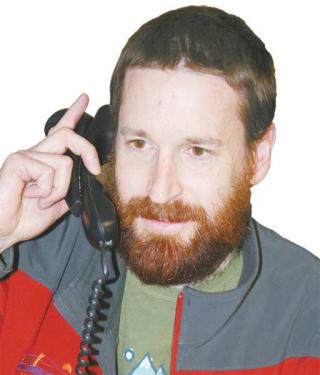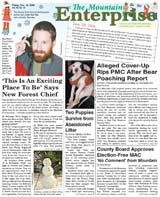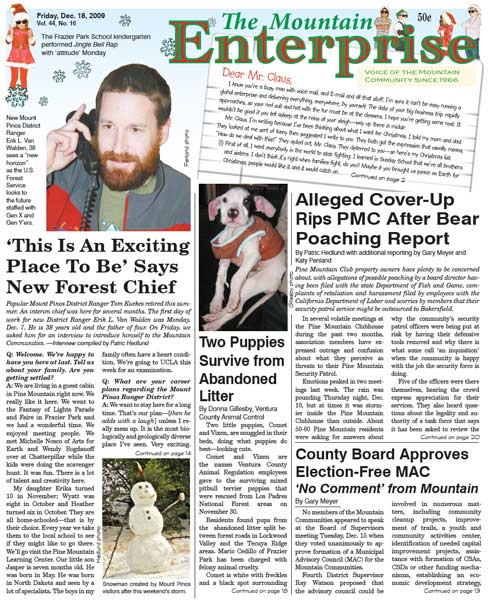
New Mount Pinos District Ranger Erik L. Van Walden, 38 sees a “new horizon” as the U.S. Forest Service looks to the future staffed with Gen X and Gen Y’ers.
Popular Mount Pinos District Ranger Tom Kuekes retired this summer. An interim chief was here for several months. The first day of work for new District Ranger Erik L. Van Walden was Monday, Dec. 7. He is 38 years old and the father of four. On Friday, we asked him for an interview to introduce himself to the Mountain Communities. —Interview compiled by Patric Hedlund
Q: Welcome. We’re happy to have you here at last. Tell us about your family. Are you getting settled?
A: We are living in a guest cabin in Pine Mountain right now. We really like it here. We went to the Fantasy of Lights Parade and Faire in Frazier Park and we had a wonderful time. We enjoyed meeting people. We met Michelle Nosco of Arts for Earth and Wendy Bogdanoff over at Chatterpillar while the kids were doing the scavenger hunt. It was fun. There is a lot of talent and creativity here.
My daughter Erika turned 10 in November; Wyatt was eight in October and Heather turned six in October. They are all home-schooled—that is by their choice. Every year we take them to the local school to see if they might like to go there. We’ll go visit the Pine Mountain Learning Center. Our little son Jasper is seven months old. He was born in May. He was born in North Dakota and seen by a lot of specialists. The boys in my family often have a heart condition. We’re going to UCLA this week for an examination.
Q: What are your career plans regarding the Mount Pinos Ranger District?
A: We want to stay here for a long time. That’s our plan—[then he adds with a laugh] unless I really mess up. It is the most biologically and geologically diverse place I’ve seen. Very exciting. The fact that we are here where the North American and Pacific tectonic plates meet…you can feel the energy. I can.
I like the variety of the landscape here, the biodiversity from 4500 to 6000 feet with the unexpected and beautiful Jeffrey pines here just up the hill from the lowlands of Bakersfield. I’m eager to get up to Mount Pinos on the moonless nights when all the astronomers are there. This is an exceptional place for astronomy.
Q: The Los Padres Forest is huge. What do you see occurring here in the Mount Pinos District of significance?
A: Both the Monterey District in King City and the Mount Pinos District of the Los Padres Forest are building new facilities. [An entirely new Chuchupate Ranger Station complex is being built in 2010, along with a snow play park area just to the west.—Editor] Good things are going on now. There have been tough times for everybody. Internally (in the forest service in general), there have been growing pains.
Centralizing our FS human resources and financial management operations into the Albuquerque Service Center began about five years ago. It was difficult to hire new employees. There were things that made it tough on people. You hire people who want to work on the ground and then they get stuck having to do their own administrative work. There were frustrations, like when it takes several months to hire people instead of a month—so the processes have controlled us and we are now taking that back.
The new national chief asked for information and feedback from the entire organization. He actually took the time and effort to analyze it thoroughly. He focused in on our processes. So now we are investing in new technology. We are controlling all our own functions ourselves from our laptops for human resources and our budgets. It isn’t a seamless transition. But I am very hopeful.
Q: How do you think the new Los Padres Forest management structure will be different?
A: I would have to guess that it is looking for people who are open minded and will allow people to feel empowered. It is looking for engagement with folks. That is the long term. The building project is short term. There are two other new rangers in this forest; they are also different from our boss’ personal style. I see us going toward a balanced force with diversity. She is going to be up here for a visit in January.
Locally, there has been a leadership vacuum [since District Ranger Tom Kuekes retired at the end of the summer—Editor] and some key people have left. I need to get people focused again over at the office. My first goal is to get our own team together. Then I want to get out and meet the community.
The forest service is going in a new direction. Did you hear about the OPM [Office of Personnel Management] survey? Out of 216 agencies polled, we were ranked 206th in all the U.S. government as a preferred place to work. We ranked low overall for effective leadership. You can Google it. Look at the survey.
The focus in the past has been “clear cut”—as in cutting trees. Now there is global climate change and water resources to consider—and much more. The mission and leadership are not as focused on one thing.
I’ve met with the leadership and there is a concerted effort to make a positive change, to make this the best forest it can be. There are some symbolic things going on, Getting construction of the new station is symbolic. Hopeful.
Q: What do you mean? Symbolic in what way?
A: The forest service is looking at a new horizon. A new generation is coming in. What is being envisioned and carried on now by the people working within the agency reflects a brighter future.
I’m kind of the leading edge of the new ‘X’ generation. I’m 38, so we’re bringing in a different set of talents and perspectives from those we are replacing. We are technologically savvy while keeping traditional values. ‘Generation Y’ coming behind us is very tech savvy. It is going against dogma that has been entrenched for many years now. This is a new time.
We are seeing more tolerance, more diversity. More expression of creativity. Less rigidity. People are more freely able to express their own talents. There is more engagement and empowerment.
The forest service was set up originally on the military model: ‘I’m a line officer, and I can pull rank.’
What I’m seeing with the younger leaders is a push away from the dogma and more question about who we are serving, how well we are serving our values, and thinking more on a global scale. In some ways it is like a rebirth of the 60s awareness of interconnectedness. The world is so much smaller, the workforce is very tuned in to how much faster things can happen now. You can let new potential flourish.
Q: Do you think you were brought in specifically because of your skill set related to the building of the new Chuchupate station?
A: I think it is a coincidence. I do have a Masters of Science in Real Estate from the finance department at University of Texas in Arlington and a BA in envronmental management from the University of Maryland. I’ve been very interested in sensitive environments. We are going for LEED certification on this project—from the U.S. Green Building Council. That is exciting. I look forward to that.
But I haven’t asked my boss why I was hired. I’m meeting with her [this week] in Goleta.
When I applied for this position I actually sent a tape of my three children and I doing a family morning yoga class that was filmed for a cable television show. I also sent a tape of me (with a big beard and my suit and tie), giving a presentation to the current Forest Service Chief Tom Tidwell about making the forest greener internally—looking at our own carbon footprint generated with 35,000 employees. With 193 million acres, we are the second largest public land manager in the world.
I also sent a poem with the application. I had just come back from a long jog and was covered with salty sweat and it just came to me…I guess it was pretty new agey. My oldest daughter (she was nine years old at the time) said, “Dad, you sent a love poem to your boss?” I said, “No, it was a thing about the billions and billions of years of the salt cycle that was part of me, sort of a stardust thing.” And my daughter said, “You really didn’t want that job, did you Daddy?” [He laughs.]
Q: What kind of politics influence the USFS?
A: All the past chiefs have been career employees, not political appointees. But everyone has a boss. After an election, the winning political party selects the Secretary of Agriculture and the undersecretary in charge of the U.S. Forest Service, and they are aligned with certain groups. As President Clinton left office he enacted the roadless rule [preserving major sections of the national forest resources from being developed—Editor]. President Bush gets in and tries many ways to reverse that. The Secretary of Agriculture now is Tom Vilsack, and the USDA Deputy Under Secretary for Natural Resources Jay Jensen will have responsibility for the U.S. Forest Service. The mission of the National Park Service is to conserve and preserve. But the U.S. Forest Service is a multi-use agency, which makes it much more complicated. It is more interesting too. So you will be getting into debates. The role of the forest service is to listen to all sides and to make decisions on behalf of the general population.
Q: Have you heard about some of the litigation affecting the Mount Pinos District, such as by Los Padres Forest Watch about mineral exploration leases and lumber contracts?
A: The mineral rights laws are ancient, they are from the 1800s. They need to be reconsidered. It is groups that challenge us and are vigilant about our actions that help us be transparent to the public. I would think that going to meet those folks would be a good idea.
The forest is very big on collaboration. Many unexpected opportunities arise when goals can be met in a collaborative process. It is difficult. It takes a lot of education for all parties. You get groups that are so focused on their own niche needs that trying to find a way to work together can be tough, yet you can accomplish so much more in collaboration. I have seen collaborative processes that have been painfully drawn out. For instance, in Montana a good partnership effort on a watershed project entailed the forest service, the timber industry and groups that had been suing each other for years with a lot of distrust. But they built a plan and a project that is really a model. The collaboration process was a model of dedication and entailed a leap of faith for everyone involved, to move beyond litigation and getting together to work through that. At times it was very painful but at the end everyone was so empowered by the process that they felt really good with the result.
This is part of the December 18, 2009 online edition of The Mountain Enterprise.
Have an opinion on this matter? We'd like to hear from you.


